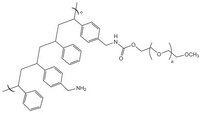NovaPEG resins
Excellent support for synthesis of long and difficult peptides. Work synergistically with pseudoproline dipeptides.
More
Excellent support for synthesis of long and difficult peptides. Work synergistically with pseudoproline dipeptides. Less
More>>
Less<<

Recommended Products
-

203119 Sigma-Aldrich Innolink™ Biotin 354S -

CR25F1006 Millipore Polygard-CR Cartridge Filter 10 in. 25 µm Code F -

SLFG85010 Millipore Millex-FG, 0.20 µm, hydrophobic PTFE, 50 mm -

341207 Sigma-Aldrich ET-18-OCH₃ - CAS 70641-51-9 - Calbiochem -

662035-5MG Sigma-Aldrich U-73122 - CAS 112648-68-7 - Calbiochem -

SCT276 Sigma-Aldrich BioTracker™ Green pH-Independent Autophagy Live Cell Probe -

804808 Sigma-Aldrich Isophthaloyl dichloride -

ELI-006-H Sigma-Aldrich IL-5 ELISPOT Antibody Pair, Human -

HGTC300SP Millipore Cartridge Housing Sanitary Gaskets 6-tube 3 in. Silicone -

MABN679 Sigma-Aldrich Anti-BHMT Antibody, clone 8C11H5
Overview
Specifications
Ordering Information
Documentation
Related Products & Applications
Product Families

NovaGel™ resins for peptide and organic synthesisNovaGel™ resins for peptide and organic synthesis: High substitution, broad solvent compatibility and excellent swelling properties make it an excellent support for peptide and organic synthesis.Learn More >> |

NovaSyn® TG resins for solid phase peptide synthesisHigh quality resins suitable for continuous flow and batch synthesis – long and challenging sequencesLearn More >> |

PEGA resinsPEGA resins swell extensively in a wide range of solvents and are ideally suited for the preparation of peptide libraries, affinity purification, and on-resin enzyme assays.Learn More >> |
Related Products By: Brand Facete
| Novabiochem® |
Categories
NovaPEG resins are identical to Chemmatrix resins and are excellent solid supports for solid phase peptide and organic synthesis 1. Unlike other PEG-based polymer supports such as NovaSyn® TG and PEGA resins which contain either polystyrene or polyacrylamide backbones, NovaPEG resin contains only PEG units. This unique composition confers excellent swelling and mechanical properties on the polymer. The resin beads have swelling properties similar to PEGA resins, but unlike PEGA resins are free flowing beads in the dry state which makes them much easier to handle. Furthermore, in contrast to polystyrene and other commonly used supports, NovaPEG resin appears not to suffer from osmotic shock when solvent is exchanged from hydrophobic to hydrophilic solvents. NovaPEG resin also has excellent chemical stability, particularly towards strong acids and bases.
The amphiphilic nature of this resin makes it an excellent support for the synthesis of difficult, aggregated peptides and of long peptides and small proteins. In a reported synthesis of Bacuma, a 38-residue potential synthetic vaccine, the use of polystyrene-based resin gave an extremely heterogeneous product whereas NovaPEG Rink Amide resin afforded the target in excellent purity and yield 1. More remarkable is the result obtained from the synthesis of β-amyloid (1-42)1. This sequence is notoriously difficult to prepare owing to its propensity to aggregate. Using NovaPEG resin, this extremely problematic peptide was obtained in a crude purity of 91% using standard Fmoc SPPS methods. NovaPEG resin also gave a spectacular result in the synthesis of HIV-protease, affording an almost homogeneous product after 78 amino acid additions 2.
Remarkable synergies have been observed when they are used in combination with pseudoproline dipeptides. For example, the syntheses of the chemokines Rantes 3 and CCL4-L14 could only be achieved by employing both NovaPEG resins and pseudoproline dipeptides.
1. F. Garcia-Martin, et al. (2006) J. Comb. Chem., 8, 213.
2. S. Frutos, et al. (2007) Int. J. Pept. Res. Ther., 13, 221.
3. F. Garcia-Martin, et al. (2006) Biopolymers, 84, 566.
4. B. G. de la Torre, et al. (2007) Int. J. Pept. Res. Ther., 13, 265.






